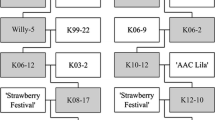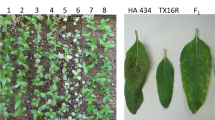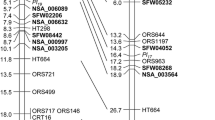Abstract
Key message
A QTL for resistance to several races of black spot co-located with the known Rrd1 locus in Rosa. A polymorphism in muRdr1A linked to black spot resistance was identified and molecular markers were designed.
Abstract
Black spot, caused by Diplocarpon rosae, is one of the most serious foliar diseases of landscape roses that reduces the marketability and weakens the plants against winter survival. Genetic resistance to black spot (BS) exists and race-specific resistance is a good target to implement marker-assisted selection. High-density single nucleotide polymorphism-based genetic maps were created for the female parent of a tetraploid cross between ‘CA60’ and ‘Singing in the Rain’ using genotyping-by-sequencing following a two-way pseudo-testcross strategy. The female linkage map was generated based on 227 individuals and included 31 linkage groups, 1055 markers, with a length of 1980 cM. Race-specific resistance to four D. rosae races (5, 7, 10, 14) was evaluated using a detached leaf assay. BS resistance was also evaluated under natural infection in the field. Resistance to races 5, 10 and 14 of D. rosae and field resistance co-located on chromosome 1. A unique sequence of 32 bp in exon 4 of the muRdr1A gene was identified in ‘CA60’ that co-segregates with D. rosae resistance. Two diagnostic markers, a presence/absence marker and an INDEL marker, specific to this sequence were designed and validated in the mapping population and a backcross population derived from ‘CA60.’ Resistance to D. rosae race 7 mapped to a different location on chromosome 1.






Similar content being viewed by others
References
Altschul SF, Gish W, Miller W, Myers EW, Lipman DJ (1990) Basic local alignment search tool. J Mol Biol 215:403–410. https://doi.org/10.1016/S0022-2836(05)80360-2
Arends D, Prins P, Jansen RC, Broman KW (2010) R/Qtl: high-throughput multiple QTL mapping. Bioinformatics 26:2990–2992. https://doi.org/10.1093/bioinformatics/btq565
Biber A, Kaufmann H, Linde M, Spiller M, Terefe D, Debener T (2010) Molecular markers from a BAC contig spanning the Rdr1 locus: a tool for marker-assisted selection in roses. Theor Appl Genet 120:765–773. https://doi.org/10.1007/s00122-009-1197-9
Blechert O, Debener T (2005) Morphological characterization of the Interaction between Diplocarpon rosae and various rose species. Plant Pathol 54:82–90. https://doi.org/10.1111/j.1365-3059.2005.01118.x
Broman KW, Wu H, Sen Ś, Churchill GA (2003) R/Qtl: QTL mapping in experimental crosses. Bioinformatics 19:889–890. https://doi.org/10.1093/bioinformatics/btg112
Broman KW, Gatti DM, Simecek P, Furlotte NA, Prins P, Sen Ś, Yandell BS, Churchill GA (2019) R/Qtl2: software for mapping quantitative trait loci with high-dimensional data and multiparent populations. Genetics 211:495–502. https://doi.org/10.1534/genetics.118.301595
de Vries DP, Dubois LAM (2001) Developments in breeding for horizontal and vertical fungus resistance in roses. Acta Hortic 552:103–112. https://doi.org/10.17660/ActaHortic.2001.552.10
Debener T (2003) Marker assisted background selection for the introgression of black spot resistance into cultivated roses. Eur J Hortic Sci 68:245–252
Debener T, Drewes-Alvarez R, Rockstroh K (1998) Identification of five physiological races of blackspot, Diplocarpon rosae, wolf on roses. Plant Breed 117:267–270. https://doi.org/10.1111/j.1439-0523.1998.tb01937.x
Gachomo EW, Dehne HW, Steiner U (2006) Microscopic evidence for the hemibiotrophic nature of Diplocarpon rosae, cause of black spot disease of rose. Physiol Mol Plant Pathol 69:86–92. https://doi.org/10.1016/j.pmpp.2007.02.002
Granados Mendoza C, Wanke S, Goetghebeur P, Samain MS (2013) Facilitating wide hybridization in hydrangea s. l. cultivars a phylogenetic and marker-assisted breeding approach. Mol Breed 32:233–239. https://doi.org/10.1007/s11032-012-9822-8
Grattapaglia D, Sederoff R (1994) Genetic Linkage maps of eucalyptus grandis and eucalyptus urophylla using a pseudo-testcross: mapping strategy and RAPD markers. Genetics 137:1121–1137
Haley CS, Knott SA (1992) A simple regression method for mapping quantitative trait loci in line crosses using flanking markers. Heredity 69:315. https://doi.org/10.1038/hdy.1992.131
Hattendorf A, Linde M, Mattiesch L, Debener T, Kaufmann H (2004) Genetic analysis of rose resistance genes and their localisation in the rose genome. Acta Hortic 651:123–130. https://doi.org/10.17660/ActaHortic.2004.651.14
Jeliazkova EA (2012) Evaluating natural products for control of black spot disease on roses. J Med Active Plants 1:13–18. https://doi.org/10.7275/r58050j3
Kaufmann H, Mattiesch L, Lörz H, Debener T (2003) Construction of a BAC library of Rosa Rugosa Thunb and assembly of a Contig spanning Rdr1 a gene that confers resistance to blackspot. Mol Genet Genom 268:666–674. https://doi.org/10.1007/s00438-002-0784-0
Koning-Boucoiran CFS, Gitonga VW, Yan Z, Dolstra O, van der Linden CG, van der Schoot J, Uenk GE et al (2012) The mode of inheritance in tetraploid cut roses. Theor Appl Genet 125:591–607. https://doi.org/10.1007/s00122-012-1855-1
Li H (2013) Aligning sequence reads, clone sequences and assembly Contigs with BWA-MEM. ArXiv:1303.3997 [q-Bio], March. https://arxiv.org/abs/1303.3997.
Li H, Handsaker B, Wysoker A, Fennell T, Ruan J, Homer N, Marth G, Abecasis G, Durbin R (2009) The Sequence Alignment/Map format and SAMtools. Bioinformatics 25(16):2078–2079
McKenna A, Hanna M, Banks E, Sivachenko A, Cibulskis K, Kernytsky A, Garimella K, Altshuler D, Gabriel S, Daly M, DePristo MA (2010) The Genome Analysis Toolkit: A MapReduce framework for analyzing next-generation DNA sequencing data. Genome Res 20(9):1297–1303
Menz I, Straube J, Linde M, Debener T (2018) The TNL gene Rdr1 confers broad-spectrum resistance to Diplocarpon rosae. Mol Plant Pathol 19:1104–1113. https://doi.org/10.1111/mpp.12589
Milne I, Stephen G, Bayer M, Cock PJA, Pritchard L, Cardle L, Shaw PD, Marshall D (2013) Using Tablet for visual exploration of second-generation sequencing data. Brief Bioinform 14(2):193–202
Neu E, Debener T (2019) Prediction of the Diplocarpon rosae secretome reveals candidate genes for effectors and virulence factors. Fungal Biol 123:231–239. https://doi.org/10.1016/j.funbio.2018.12.003
Nguyen THN, Winkelmann T, Debener T (2019) Development of markers for shoot organogenesis in roses. Acta Hortic 1232:7–14. https://doi.org/10.17660/ActaHortic.2019.1232.2
Ogilvie IS, Agriculture Canada (1993) Winter-hardy roses from agriculture Canada. Communications Branch, Agriculture Canada
Peng Y, Leung HCM, Yiu SM, Chin FYL (2012) IDBA-UD: a de novo assembler for single-cell and metagenomic sequencing data with highly uneven depth. Bioinformatics 28:1420–1428. https://doi.org/10.1093/bioinformatics/bts174
R Core Team (2019) R: A Language and Environment for Statistical Computing. https://www.R-project.org/
Raymond O, Gouzy J, Just J, Badouin H, Verdenaud M, Lemainque A, Vergne P et al (2018) The Rosa genome provides new insights into the domestication of modern roses. Nat Genet 50:772–777. https://doi.org/10.1038/s41588-018-0110-3
Sievers F, Wilm A, Dineen DG, Gibson TJ, Karplus K, Li W, Lopez R, McWilliam H, Remmert M, Söding J, Thompson JD, Higgins DG (2011) Fast, scalable generation of high-quality protein multiple sequence alignments using clustal omega. Mol Syst Biol 7:539. https://doi.org/10.1038/msb.2011.75
Smith BL, Lu CP, Alvarado Bremer JR (2010) High-resolution melting analysis (HRMA): a highly sensitive inexpensive genotyping alternative for population studies. Mol Ecol Resour 10:193–196. https://doi.org/10.1111/j.1755-0998.2009.02726.x
Spiller M, Linde M, Hibrand-Saint Oyant L, Tsai CJ, Byrne DH, Smulders MJM, Foucher F, Debener T (2011) Towards a unified genetic map for diploid roses. Theor Appl Genet 122:489–500. https://doi.org/10.1007/s00122-010-1463-x
Svejda F, Mcgee H (2006) Bouquets and thorns (letter to the editor). In: The Beaver: exploring Canada’s history, vol 86, p 6. Publisher: Canada's National History Society, Ottawa
Taylor J, Butler D (2017) R package ASMap: efficient genetic linkage map construction and diagnosis. J Stat Softw 79:1–29. https://doi.org/10.18637/jss.v079.i06
Terefe-Ayana D, Debener T (2011) An SSR from the Leucine-Rich repeat region of the rose Rdr1 gene family is a useful resistance gene analogue marker for roses and other rosaceae: an SSR from the Leucine-Rich repeat region. Plant Breed 130:291–293. https://doi.org/10.1111/j.1439-0523.2010.01780.x
Terefe-Ayana D, Yasmin A, Le TL, Kaufmann H, Biber A, Kühr A, Linde M, Debener T (2011) Mining disease-resistance genes in roses: functional and molecular characterization of the Rdr1 locus. Front Plant Sci 2:35. https://doi.org/10.3389/fpls.2011.00035
Terefe-Ayana D, Kaufmann H, Linde M, Debener T (2012) Evolution of the Rdr1 TNL-cluster in roses and other rosaceous species. BMC Genom 13:409. https://doi.org/10.1186/1471-2164-13-409
Untergasser A, Cutcutache I, Koressaar T, Ye J, Faircloth BC, Remm M, Rozen SG (2012) Primer3—new capabilities and interfaces. Nucl Acids Res 40:115. https://doi.org/10.1093/nar/gks596
von Malek B, Debener T (1998) Genetic analysis of resistance to blackspot (Diplocarpon rosae) in tetraploid roses. Theor Appl Genet 96:228–231. https://doi.org/10.1007/s001220050731
Voorrips RE (2002) MapChart: software for the graphical presentation of linkage maps and QTLs. J Hered 93:77–78. https://doi.org/10.1093/jhered/93.1.77
Vukosavljev M, Zhang J, Esselink GD, van Westende WPC, Cox P, Visser RGF, Arens P, Smulders MJM (2013) Genetic diversity and differentiation in roses: a garden rose perspective. Sci Hortic 162:320–332. https://doi.org/10.1016/j.scienta.2013.08.015
Waliczek TM, Byrne DH, Holeman DJ (2015) Growers’ and consumers’ knowledge, attitudes and opinions regarding roses available for purchase. Acta Hortic 1064:235–239. https://doi.org/10.17660/ActaHortic.2015.1064.26
Whitaker VM, Bradeen JM, Debener T, Biber A, Hokanson SC (2010a) Rdr3, a novel locus conferring black spot disease resistance in tetraploid rose: genetic analysis, LRR profiling, and SCAR marker development. Theor Appl Genet 120:573–585. https://doi.org/10.1007/s00122-009-1177-0
Whitaker VM, Debener T, Roberts AV, Hokanson SC (2010b) A standard set of host differentials and unified nomenclature for an international collection of Diplocarpon rosae races. Plant Pathol 59:745–752. https://doi.org/10.1111/j.1365-3059.2010.02281.x
Wu Y, Bhat PR, Close TJ, Lonardi S (2008) Efficient and accurate construction of genetic linkage maps from the minimum spanning tree of a graph. PLoS Genet 4:e1000212. https://doi.org/10.1371/journal.pgen.1000212
Yagi M (2013) Application of DNA markers for breeding carnations resistant to bacterial wilt. Jpn Agric Res Q 47:29–35. https://doi.org/10.6090/jarq.47.29
Yokoya K, Kandasamy KI, Walker S, Mandegaran Z, Roberts AV (2000) Resistance of roses to pathotypes of Diplocarpon rosae. Ann Appl Biol 136:15–20. https://doi.org/10.1111/j.1744-7348.2000.tb00003.x
Zlesak DC, Harp DA, Zuzek K, Sloan JJ, Owings A, George SW (2015) Earth-kind® rose trialing: an international model for the identification of regionally-adapted landscape roses. In: VI international symposium on rose research and cultivation, pp 123–29. https://doi.org/10.17660/ActaHortic.2015.1064.15.
Zurn JD, Zlesak DC, Holen M, Bradeen JM, Hokanson SC, Bassil NV (2018) Mapping a novel black spot resistance locus in the climbing rose brite eyesTM (‘RADbrite’). Front Plant Sci 9:21. https://doi.org/10.3389/fpls.2018.01730
Acknowledgments
This work was supported by funding from the Vineland Research and Innovation Centre, Agriculture and Agri-Food Canada Growing Forward 2 project #AIP-P013, the Canadian Nursery Landscape Association, Landscape Manitoba and Landscape Alberta.
Author information
Authors and Affiliations
Contributions
CR and DS designed the experiments. CR implemented the experiments, conducted the phenotyping, mapping, and data analysis. TB and JO contributed to GBS library preparation and bioinformatics support. RL contributed to marker development. CR authored the manuscript. DS, TB and EL edited the manuscript. All authors read and approved the final manuscript.
Corresponding author
Ethics declarations
Conflict of interest
The authors declare that they have no conflict of interest.
Additional information
Communicated by Herman J. van Eck.
Publisher's Note
Springer Nature remains neutral with regard to jurisdictional claims in published maps and institutional affiliations.
Electronic supplementary material
Below is the link to the electronic supplementary material.
Rights and permissions
About this article
Cite this article
Rouet, C., Lee, E.A., Banks, T. et al. Identification of a polymorphism within the Rosa multiflora muRdr1A gene linked to resistance to multiple races of Diplocarpon rosae W. in tetraploid garden roses (Rosa × hybrida). Theor Appl Genet 133, 103–117 (2020). https://doi.org/10.1007/s00122-019-03443-9
Received:
Accepted:
Published:
Issue Date:
DOI: https://doi.org/10.1007/s00122-019-03443-9




